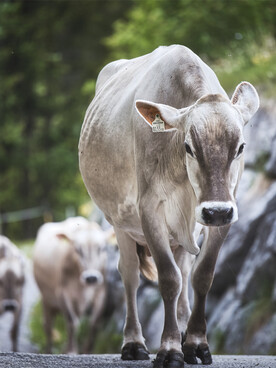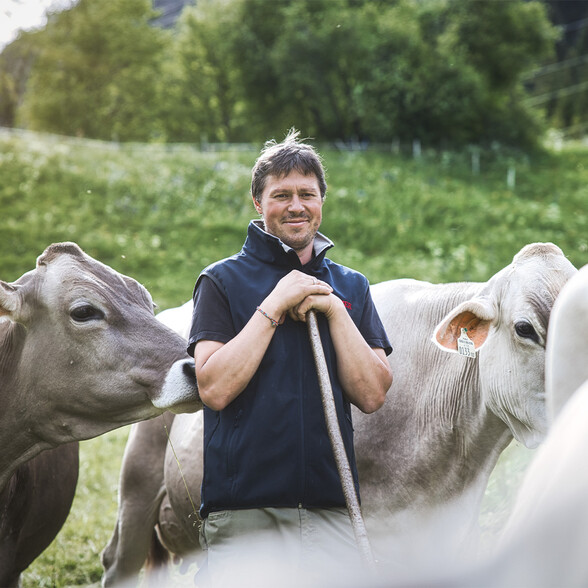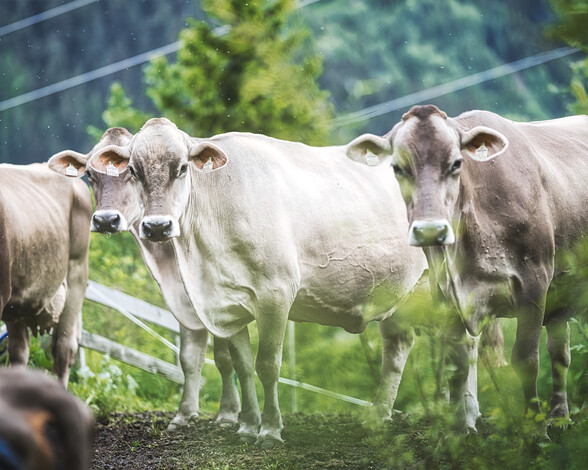”Every cow has a name“
Livestock in St. Anton am Arlberg
It takes a fair amount of idealism to run a farm these days. Even more so in mountainous regions like the Arlberg. Yet that is precisely where farming plays an important role in maintaining the landscape and preserving its identity. Thomas Strolz, local farmers' chairman in St. Anton am Arlberg, and his views on new opportunities, old cows and a passion that never wanes.
What role does cattle farming play for tourism in St. Anton am Arlberg?
Many farms, including my own, are now run on a side-line basis. Nonetheless, the local farmers make an enormous contribution, especially to summer tourism. Our breeding cattle spend the summer grazing on the alpine pastures - young cattle on Mounts Rendl and Galzig, dairy cows at Putzen and Tritschalpe. Without our clean-up work after winter and regular grazing, the valuable cultural landscape of the alpine pastures would become overgrown and thus unattractive for tourism.

The products are also regional trademarks.
In summer, the milk is processed directly on the alp into alpine cheese and butter. These are real specialities that you should certainly sample. In St. Anton am Arlberg, we generally focus on quality instead of quantity because of the small-scale structure of the farms. Eggs, milk, cheese, meat, sausage, etc. are very popular with the locals. New initiatives such as the Regiobox, which offers fresh products from vending machines around the clock, bring producers and consumers even closer together. In some cases, there are already cooperative agreements with the restaurant and hotel sector, which we hope to expand upon.

What is your opinion on the growing awareness of regionalism?
The awareness and appreciation for authentic regional food has increased significantly. I also observe this with my own houseguests, who enthusiastically drink the farm's milk from our breakfast buffet. Here in St. Anton am Arlberg, guests experience at first-hand how much work goes into producing quality food. Clear cycles and short transport routes are becoming increasingly important for consumers, but also offer us farmers a high added value. Projects such as the modernisation of the slaughterhouse in Fließ show how regional supply stability and high animal welfare standards can function.
The term animal welfare is currently on everyone's lips.
It may be a new concept in the food industry, but caring for animals is a foregone conclusion on our familyrun farms. If you keep a cow in your barn for 13, 14, 15 years and she has given you a calf every year, you don't want to send her on a long road into the unknown when her time comes to an end. We build a close relationship with our animals. We even give every cow a name.

On the other hand, the animals know you quite well too, don't they?
Yes, of course. My cows spend the winter in the barn, which means I have to tend to them every day and they are used to being close to humans from an early age. This has the advantage that hikers hardly bother them at all on the alp. If visitors to the mountain grazing pastures observe a few basic rules, there is nothing to prevent cattle and humans from living together in harmony. Only people with dogs should exercise a little more caution. Dangerous situations arise when dogs are not let off the lead when an animal charges at them.
Finally: why do you choose to remain a farmer?
If you grew up in a farming family like I did, with a father who was also an enthusiastic breeder, you don't really have a choice. The passion is in your blood. I need to have contact with the animals and can’t imagine it being any other way.
Safe hiking: 10 rules on how to behave around grazing livestock

Avoid contact, do not feed the animals!

Keep calm, do not startle grazing animals!

Avoid encounters between cows and dogs!

Keep dogs on a short leash. Immediately unleash the dog if an animal charges at them!

Do not leave hiking trails on alpine grazing pastures and meadows!

If a grazing animal blocks your path, keep as much distance as possible!

When approaching grazing animals: stay calm, do not turn your back, avoid the animals!

Leave the grazing area quickly at the first sign of any agitation!

Pay attention to fences! If there is a gate, use it, then close it properly and cross the pasture quickly!

Treat the people working here, nature and the animals with respect!